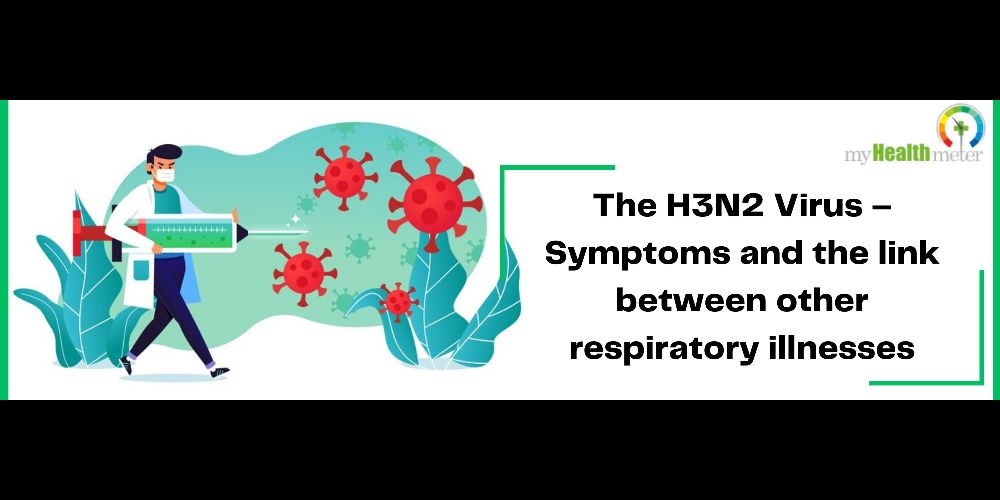The H3N2 Virus – Symptoms and the link between other respiratory illnesses
-
March 20, 2023
-
751 Views
The H3N2 Virus – Symptoms and the link between other respiratory illnesses
The H3N2 virus, also known as the Hong Kong flu, is a subtype of the influenza A virus that first emerged in Hong Kong in 1968. Since then, it has caused several outbreaks around the world, including in India. In this blog, we will discuss the impact of the H3N2 virus in India, its symptoms, and how to prevent its spread.
What is the H3N2 virus?
The H3N2 virus is a type of influenza virus that primarily affects the respiratory system. It is highly contagious and can cause severe illness in people of all ages, particularly the elderly and those with underlying health conditions. The virus spreads through respiratory droplets when an infected person coughs, sneezes, or talks.
How H3N2 virus can lead to respiratory illnesses:
The H3N2 virus can lead to respiratory illnesses such as pneumonia, bronchitis, and sinusitis by weakening the immune system and damaging the respiratory tract. When the immune system is weakened, the body becomes more vulnerable to other infections and irritants, making it more likely to develop complications.
Pneumonia:
Pneumonia is a common complication of influenza caused by the H3N2 virus. The virus damages the lining of the respiratory tract, making it easier for bacteria to infect the lungs. The bacteria can cause inflammation in the air sacs in the lungs, leading to symptoms such as cough, fever, shortness of breath, and chest pain.
Bronchitis:
Bronchitis is another respiratory illness that can be caused by the H3N2 virus. The virus can damage the bronchial tubes that carry air to and from the lungs, making them more susceptible to infection. The symptoms of bronchitis include cough, wheezing, chest discomfort, and difficulty breathing.
Sinusitis:
Sinusitis is a condition that occurs when the sinuses become inflamed due to an infection or other factors. The H3N2 virus can damage the respiratory tract, leading to inflammation of the sinuses. The symptoms of sinusitis include nasal congestion, facial pain, headache, and fever.
Symptoms of H3N2 virus:
The symptoms of the H3N2 virus are similar to those of other types of influenza viruses. The most common symptoms include:
- Fever
- Cough
- Sore throat
- Runny or stuffy nose
- Body aches
- Headache
- Fatigue
- Chills
In severe cases, the virus can cause pneumonia, which can be life-threatening, especially in young children, the elderly, and those with weakened immune systems.
Impact of H3N2 virus in India:
India has experienced several outbreaks of the H3N2 virus over the years. In 2014, a large outbreak occurred in Rajasthan, which affected more than 22,000 people and resulted in over 600 deaths. In 2017, another outbreak occurred in Maharashtra, which affected more than 700 people and resulted in over 50 deaths.
The H3N2 virus has a significant impact on public health in India, particularly during the winter months when influenza activity is at its peak. The virus can lead to a high burden on the healthcare system, with hospitals and clinics overwhelmed with patients seeking medical care.
According to medical professionals in hospitals across India, there have been a spike in cases this year and this is partly due to the weather change that is influencing this spike. Although this may seem like a similar threat to COVID-19 pandemic, there are ways to prevent the spread of the virus.
Preventing the spread of the H3N2 virus:
Preventing the spread of the H3N2 virus is essential to reduce the risk of developing respiratory illnesses such as pneumonia, bronchitis, and sinusitis. The following measures can help prevent the spread of the virus:
- Getting vaccinated: The influenza vaccine is the most effective way to prevent the H3N2 virus. The vaccine is widely available and recommended for everyone, particularly those at high risk of complications from influenza, such as young children, the elderly, and those with underlying health conditions.
- Practicing good hygiene: Regularly washing hands with soap and water, covering the mouth and nose when coughing or sneezing, and avoiding close contact with people who are sick can help prevent the spread of the virus.
- Staying home when sick: People who are sick with influenza should stay home from work or school until they are no longer contagious to avoid spreading the virus to others.
Conclusion:
The H3N2 virus is a highly contagious and potentially severe respiratory illness that can have a significant impact on public health in India. The virus can cause a high burden on the healthcare system, particularly during the winter months. Preventing the spread of the virus through vaccination, good hygiene, and staying home when sick is essential to reduce its impact on public health.





